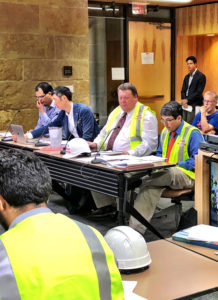Adopting code a significant challenge
Wednesday, June 6, 2018 by
Jo Clifton Mayor Steve Adler continued his quest to gain consensus on CodeNEXT Tuesday as City Council began to deliberate adoption of the new Land Development Code. In pursuit of that end, Adler gave each person on the dais – including City Manager Spencer Cronk and staff from the Planning and Zoning Department – a hard hat and a yellow vest emblazoned with the label “Team Austin.”
“I think it would be a significant disappointment” if Council failed to adopt the new code after all the money and time that has gone into writing it, Adler said. Council has to recognize that this is “a very wicked problem. But I hope we can also recognize that even though it’s a wicked problem, it’s not about wicked people.” To that end, he said that he hoped that wearing the Team Austin uniforms would help Council to recognize that they’re all ultimately on the same side.

Adler and Council Member Ann Kitchen seemed to favor going through the draft policy papers the different Council members had put together in small groups. This process turned out to be tedious and time-consuming. First, Council addressed the goals document, which Adler worked on with Kitchen and Council Member Alison Alter, with support from Council Member Leslie Pool.
Even though Council voted on keeping and removing different goals, those goals that were not acceptable to a majority were simply “bookmarked,” so they may be brought back with slightly different language later.
Mayor Pro Tem Kathie Tovo objected to the wording of a number of her fellow Council members’ goals, such as working toward a code that “allows exceptions to building requirements for small accessory dwelling units (ADUs) to provide incentives to preserve the original residence or create affordability.”
Tovo said she would be opposed to such changes if it meant, for example, eliminating the requirement that all new residential units be accessible to people with disabilities. She also objected to the idea of allowing more administrative approvals for housing. This was just one of her objections, and several other Council members joined her in expressing their reservations.
On the other hand, Council members Greg Casar and Delia Garza both expressed frustration with the process, which included showing support by votes numbered one through five (for each Council member) depending on their level of support for an item.
Casar said he would “give five happily to keep moving forward, as long as that vote isn’t saying I’m good with” the words or concepts that are being deleted at the behest of other Council members.
At about 12:15 p.m. Garza said, “If we’re going to do this all day, I’m not coming back after lunch. I have to prepare for a trip tomorrow for a fellowship in economic development. So, I’m trying to be patient and respectful but I guess I’d like to know when we’re going to actually start digging into the weeds.”
And even though she said she could respect the fact that each Council member was “coming from a different place … in a lot of ways, lines have been drawn.” Garza left a few minutes later and did not return after lunch, as expected.
Garza, Casar and Council members Pio Renteria and Jimmy Flannigan have formed a coalition of supporters for the changes envisioned by CodeNEXT, with an emphasis on greater density and increased housing affordability.
Planning and Zoning Director Greg Guernsey explained that adoption of a new Land Development Code would not solve all the city’s problems, particularly housing affordability. The city will still need tools like tax credits, he said.
In addition, Guernsey said, CodeNEXT will provide more transportation options, “but it will not take cars off the streets. … It’s very much a code that looks to the future, so if Council were to approve this when you wake up the next morning, the world isn’t changed overnight.”
That drastic change is obviously what people who oppose CodeNEXT are afraid of, and Guernsey tried to assuage those fears.
“Those uses that you might have on your property that were there before you were annexed or before the zoning went into effect are still nonconforming, and those can exist. Buildings that were built before (the McMansion ordinance) went into effect … are still legal and lawful. You don’t have to vacate the building and you don’t have to run out and get a building permit,” Guernsey said. “But a change is coming and this is really part of the discussion that was in Imagine Austin. In 2010, we had about 790,000 people. Today we’re close to 970,000.”
If you added the entire population of both Pflugerville and Round Rock in 2010 to the population of Austin at that time, Guernsey said, it would not be as large as the influx of people into Austin since then.
Map courtesy of city of Austin. Photo by Jo Clifton.
The Austin Monitor’s work is made possible by donations from the community. Though our reporting covers donors from time to time, we are careful to keep business and editorial efforts separate while maintaining transparency. A complete list of donors is available here, and our code of ethics is explained here.
You're a community leader
And we’re honored you look to us for serious, in-depth news. You know a strong community needs local and dedicated watchdog reporting. We’re here for you and that won’t change. Now will you take the powerful next step and support our nonprofit news organization?










